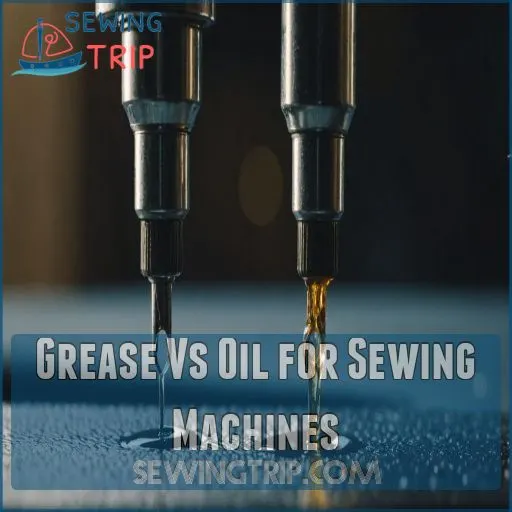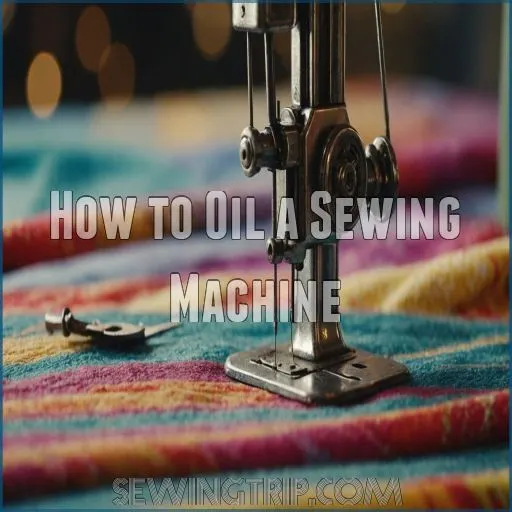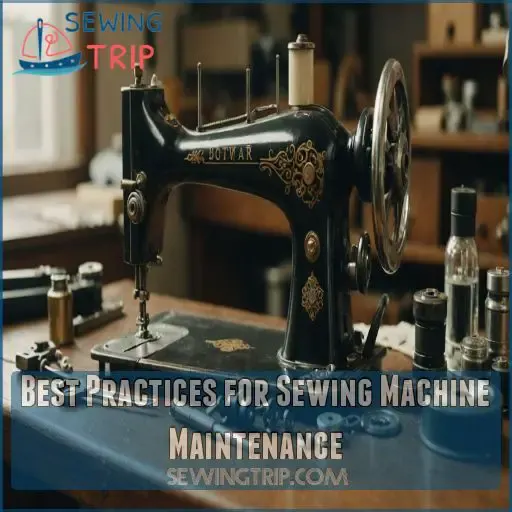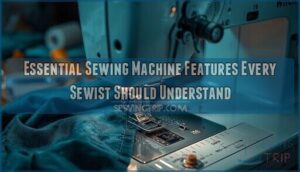This site is supported by our readers. We may earn a commission, at no cost to you, if you purchase through links.
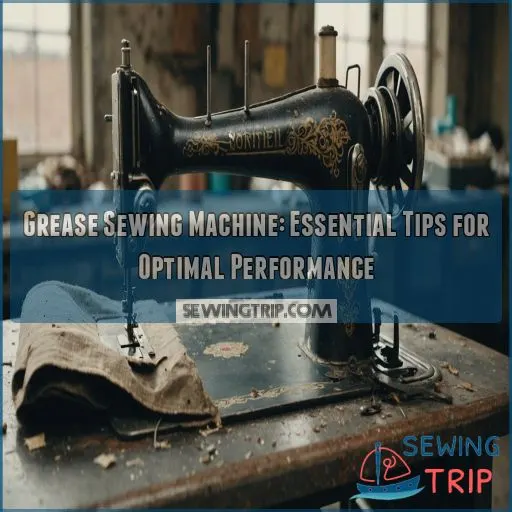
While oil flows to keep parts moving, grease is thicker and isn’t as gather-up-and-go, making it perfect for high-friction spots like gears.
You’ll want to grease sewing machine components every now and then to avoid any nasty surprises like erratic stitching or broken needles.
Just remember, too much grease can turn everything into a slippery mess! Choose wisely, and your sewing machine will purr like a contented kitten.
Curious about choosing the right grease? There’s more to explore in the article!
Table Of Contents
- Key Takeaways
- Types of Sewing Machine Lubricants
- Importance of Regular Lubrication
- Choosing the Right Lubricant for Your Machine
- Oil Dispensers and Applicators
- Common Mistakes to Avoid When Lubricating
- Grease Vs Oil for Sewing Machines
- How to Oil a Sewing Machine
- Best Practices for Sewing Machine Maintenance
- Troubleshooting Common Lubrication Issues
- Frequently Asked Questions (FAQs)
- Conclusion
Key Takeaways
- Grease is like a spa day for your sewing machine – it keeps those high-friction parts running smoothly. Just don’t go overboard, or you’ll have a slippery mess on your hands!
- Choosing the right lubricant is key – oils are great for daily use, while greases are better suited for heavy-duty parts. Get to know the differences so you can keep your machine running smoothly.
- Regular lubrication is a must if you want your sewing machine to work like a dream. It prevents wear and tear, ensures smooth operation, and even saves you money on costly repairs down the line.
- When oiling, a little goes a long way. Follow your machine’s manual and stick to the recommended oiling points – you don’t want to turn your sewing space into an oil slick!
Types of Sewing Machine Lubricants
Understanding the different types of sewing machine lubricants can feel like choosing between bacon grease and olive oil for breakfast—they each have their proper place.
From non-staining machine oil to silicone thread lubricants, picking the right one keeps your sewing machine humming happily and your projects on point.
Non-Staining Machine Oil
Don’t let your sewing machine’s performance hit a snag when it comes to proper maintenance. Pick Lilly White sewing machine oil for non-staining lubrication. This oil maintains longevity; just store it properly.
Silicone Concentrate Thread Lubricant
For your overlock and serger machines, a silicone concentrate thread lubricant can work wonders, reducing friction and keeping your threads smooth and strong. Give it a try!
Dry Silicone Spray
Love silk-smooth sewing? Dry silicone spray keeps embroidery machines purring like kittens. It’s like sunscreen for stitches, preventing snags! Use sparingly; you don’t want slippery disasters. Happy crafting!
Differences Between Various Lubricants
Understanding the differences between oil, grease, and dry silicone helps you master sewing machine maintenance.
Remember:
- Oil: Ideal for daily use.
- Grease: Suited for heavy-duty parts.
- Dry Silicone: Reduces friction efficiently.
Importance of Regular Lubrication
If you want your sewing machine to work smoothly without all those awkward noises, regular lubrication is your best friend.
It keeps your machine humming along happily, but it also saves you from costly repairs and keeps your embroidery looking fabulous!
Preventing Wear and Tear
Regular oiling prevents excessive wear on your sewing machine’s intricate parts, saving you from costly repairs down the line. A well-lubricated machine runs like a dream!
Smooth Operation and Performance
Speaking of smooth operation, lubrication is like your sewing machine’s morning coffee.
Proper lubrication helps you get top stitch quality, stellar needle performance, and a longer machine lifespan.
Don’t skip yours!
Cost Savings Through Maintenance
While your sewing machine hums along smoothly, regular maintenance keeps repair costs at bay. Think of it as preventative upkeep; extending your machine’s lifespan means more DIY projects and long-term savings!
Impact on Embroidery Quality
You’ve tackled cost restrictions, now imagine poor stitching! Without proper lubrication, expect erratic stitching, skewed designs, broken needles, and puckering. Consistent care keeps every stitch spot-on and flawless!
Choosing the Right Lubricant for Your Machine
Choosing the right lubricant for your sewing machine can feel like a confusing puzzle, but don’t worry!
From non-staining oils to specialized silicone sprays, we’ll help you find the perfect match for your machine’s needs.
Factors to Consider
Regular lubrication is like your car’s oil change—ignoring it can lead to trouble!
Consider machine type, oil viscosity, and frequency.
Balance brand reliability with your budget.
Your machine’ll purr!
High-End Embroidery Machines and Their Requirements
High-end embroidery machines demand specialized oils for detailed maintenance.
A well-structured maintenance schedule and regular professional servicing keep these intricate beauties humming.
Compatibility With Machine Components
When choosing lubricants, consider compatibility with machine components and oil viscosity. A well-suited grease application reduces component wear. Like a puzzle, the right fit matters! Material compatibility is key.
Avoiding Incompatible Lubricants
Steer clear of mismatched lubricants – they can wreak havoc on your machine! Stick to the right oil type to keep your sewing pal purring like a kitten.
Oil Dispensers and Applicators
Keeping your sewing machine well-lubricated is easier with the right oil dispenser—because no one wants their machine squeaking louder than a morning bird!
Precision Needle Point Oil Pen and Zoom Spout Extendable Oiler will make sure every hinge and spindle gets the care it needs without all the mess.
Refillable Precision Needle Point Oil Pen
You’ve got a real gem in the refillable precision needle point oil pen. This handy tool makes applying sewing machine oil a breeze. It’s precise, mess-free, and easy to handle.
Deluxe Plastic Oiler With Angled Spout
The Deluxe Plastic Oiler with Angled Spout makes oiling easy-peasy. Its durable, leak-proof design plus a 4-inch spout helps you reach tricky spots—like finding Waldo in a crowd.
Mini Plastic Oiler With Retractable Spout
The compact, leak-proof Mini Plastic Oiler with its retractable 4-inch spout provides precise oil application, making it a handy choice for your sewing machine maintenance needs.
Zoom Spout Extendable Oiler
With its extendable spout, the Zoom spout oiler reaches tricky spots with ease. Unlike needle pens, it doesn’t spill. Keep it clean for longevity and enjoyable sewing sessions!
Common Mistakes to Avoid When Lubricating
Lubricating your sewing machine might seem simple, but trust me, using too much oil is about as useful as wearing a wool sweater in a sauna.
To keep your machine running like a dream, know where to apply oil and avoid turning it into an oiled-up slip ‘n slide by skipping regular maintenance or using the wrong lubricant.
Using Excessive Oil
Too much oil’s like rain on a picnic—nobody wins! It can cause oil stains and thread damage. Avoid sticky fabric with regular machine cleaning to prevent oil build-up.
Applying Oil to the Wrong Parts
Applying oil to the wrong parts can lead to messy stains and damage. Focus on the recommended lubrication points to keep your machine running smoothly.
Neglecting Regular Maintenance
Skipping maintenance? That’s like expecting your car to purr without oil. Regular care prevents hefty repair costs and keeps:
- Machine lifespan intact
- Stitch quality sharp
- Noise levels low
- Fabric damage minimal
Using the Wrong Type of Lubricant
Imagine using the wrong type of lubricant—it’s like using syrup instead of oil.
Lubricant damage can lead to sticky threads, oil contamination, and worn machine parts.
Stick to sewing machine oil!
Grease Vs Oil for Sewing Machines
Choosing between grease and oil for your sewing machine can feel like deciding whether to put mayonnaise or mustard on a sandwich—each serves a purpose, but they aren’t interchangeable.
Using the right one at the right time makes sure your machine runs smoothly and avoids unnecessary "uh-oh" moments mid-stitch.
Key Differences Between Grease and Oil
Grease and oil have distinct properties – grease is thicker, more viscous, and better suited for high-friction areas, while oil flows more freely and excels at reducing wear. Consider the specific needs of your machine when choosing between the two.
- Grease is thicker and more viscous
- Grease excels in high-friction areas
- Oil flows more freely, reducing wear
When to Use Grease Vs Oil
Choosing grease or oil for your sewing machine isn’t rocket science. Use grease for gears and oil for fast-moving parts. Think of grease as peanut butter’s slower cousin and oil like a quick coffee fix.
| Lubrication Type | Use Description |
|---|---|
| Grease | Gears and larger parts |
| Oil | Fast-moving components |
| Grease | Thicker, long-lasting |
| Oil | Easy to apply, precise |
| Grease | Slower applications |
Benefits and Drawbacks of Each
Finding the right lubricant for your machine is like finding the perfect pair of shoes. Oil offers smooth and nimble performance, great for daily prancing, while grease, a sturdy boot, makes for a long life and quality, minimizing replacement costs.
How to Oil a Sewing Machine
Oiling your sewing machine might seem tricky, but with a few simple steps, you’ll keep it humming like a contented kitten.
Just remember, a little oil goes a long way—nobody wants a slippery situation with fabric careening across the room!
Pre-Oiling Precautions
Before oiling your sewing machine, unplug it and give it a thorough cleaning. Removing lint and debris will help the oil do its job properly. Consult your manual for specific instructions.
Step-by-Step Oiling Instructions
Dive right in—grab your oil pen or bottle and apply oil sparingly, like seasoning a salad. Stick to the oiling frequency recommended by your machine’s manual for best results!
Tips for Specific Machine Parts
Sure, you oil the moving parts like needle bar and presser foot. Don’t forget the bobbin winder and feed dog! Your machine will purr like a contented cat.
Cleaning and Maintenance
You’ve got your parts lubed; now focus on cleaning. Keep a brush handy for lint removal, and stick to a maintenance schedule. Good storage tips prevent thread tension drama like storing threads in a cool, dry place!
Best Practices for Sewing Machine Maintenance
Keeping your sewing machine in tip-top shape is key to its longevity.
From regular cleaning schedules to smart storage habits, we’ve got the inside scoop on maintaining your machine like a pro.
Regular Cleaning Schedule
Keeping your sewing machine in tip-top shape relies on a regular cleaning schedule. Stick to these practices:
- Check cleaning frequency.
- Prioritize lint removal.
- Use effective cleaning tools.
- Prevent dust accumulation.
Storage and Handling Tips
Speaking of cleaning, let’s stash your sewing machine in a dry, cool space. Avoid extreme temperature and humidity. While transporting, cushion it against jostles. It’ll thank you later!
Troubleshooting Common Issues
Store your machine properly, and if it starts causing skipped stitches or thread breakage, check for lubrication issues. Machine noise? Fix needle jamming with a quick oil check!
Scheduling Professional Maintenance
Schedule professional tune-ups every 12-18 months to keep your sewing machine humming. Consult the manual for manufacturer recommendations, and read online reviews to find a trusted technician.
- Maintain warranty coverage
- Prevent costly repairs
- Extend machine’s lifespan
Troubleshooting Common Lubrication Issues
When your sewing machine starts acting up, it might be crying out for some TLC, especially in the lubrication department.
Don’t panic—figuring out greasy snafus is often as simple as spotting a few common symptoms, and we’ve got the trusty tips to help you solve them with ease.
Identifying the Source of the Problem
Ever feel like your sewing machine’s gotten noisier than a popcorn maker? Check for skipped stitches or thread breakage. They often signal lubrication issues slowing your machine’s performance.
Common Symptoms of Lubrication Issues
Feeling a bit like your machine’s stuck in molasses? Watch for skipped stitches, unexpected machine noise, thread breakage, needle jamming, or stiff movement. These hiccups scream lubrication issues!
Solutions for Specific Issues
Experiencing skipped stitches or thread breakage? A few drops of the right oil can work wonders. Squeaky noises or machine jams? Lubricate those tricky spots, stat!
- Check the manual for oiling points
- Use the proper lubricant for your machine
- Avoid over-oiling to prevent stains
- Clean and maintain regularly for peak performance
Preventing Future Problems
Keeping your sewing machine humming requires a regular lubrication schedule and preventative care. Here’s a quick guide to troubleshooting tips:
| Issue | Possible Cause | Solution | Prevention |
|---|---|---|---|
| Noisy operation | Lack of oil | Apply oil | Oil regularly |
| Skipped stitches | Dirty parts | Clean machine | Maintain cleanliness |
| Tight handwheel | Excess lubrication | Wipe excess oil | Use right amount of oil |
| Fabric marks | Wrong lubricant | Switch oil | Check oil compatibility before use |
Frequently Asked Questions (FAQs)
What to use to grease a sewing machine?
You should use a non-staining machine oil, like Lily White Embroidery & Sewing Machine Oil, for greasing your machine.
It’s like your machine’s best friend, keeping everything smooth without leaving any nasty surprises on fabric!
What is the best grease for sewing machines?
If you really enjoy your sewing machine screeching like a banshee, skip the grease!
But in all seriousness, use Triflow or the manufacturer’s grease.
They’re perfect for keeping those parts slick and trouble-free.
Can you use WD-40 on a sewing machine?
Don’t use WD-40 on your sewing machine – it’s not the right lubricant.
Sewing machine oil is the specialized lubricant you need to keep your machine running smoothly and prevent damage to delicate parts.
Trust me, your machine will thank you!
Can I use vaseline to lubricate my sewing machine?
Using Vaseline is like putting peanut butter in your car engine—it’s a recipe for disaster. Opt for sewing machine oil instead. It glides smoothly, keeps your machine purring like a kitten, and avoids sticky situations!
How often should grease be applied to gears?
Grease your sewing machine gears every 50 hours of use to keep them running smooth as butter (Source).
It’s like giving your machine a spa treatment, ensuring longevity and peak performance.
So, grab that grease and pamper away!
Can different machine parts require different greases?
Each sewing machine part is like a puzzle piece that needs specific grease.
Embrace variety; some gears crave thicker, protective grease, while others dance smoothly with a lighter touch.
Know each part’s preference for harmony.
What are signs of inadequate greasing?
If your machine’s running rough, making strange noises, or struggling to stitch smoothly, it’s a surefire sign you’re not greasing it enough.
Don’t let your machine suffer – give it a good oiling and watch it purr like a kitten!
Is there a specific type of grease for vintage machines?
For vintage sewing machines, you’ll want a non-staining, light grease that’s easy on their old joints.
It’s like giving them a gentle massage!
Check the manual or a vintage specialist for specific recommendations.
Can excessive grease harm the sewing machine?
You don’t want to over-grease your sewing machine, or you’ll be in a sticky situation!
Excess grease can attract dust and lint, gumming up the works and causing more problems than it solves (Source).
Conclusion
Master your machine, grease your sewing machine, and enhance its life! A well-maintained machine helps you create smooth stitches, fewer surprises, and delightful sewing sessions.
Don’t underestimate the power of regular greasing to keep your machine purring like a cat with a new toy.
Choose the right grease, avoid overdoing it, and your creative projects will flow smoothly.
Keep it clean, keep it moving, and save yourself some repair headaches down the line. Happy sewing adventures await you!






